Coffee farmers are adapting to challenges by adopting resilient varieties like Castillo 2.0 and implementing sustainable practices such as shade-grown methods and organic fertilizers. They’re collaborating with research institutions to access essential knowledge on climate-resilient crops. By balancing traditional methods with modern techniques, they enhance biodiversity and combat environmental threats. As they navigate these strategies, they also face economic pressures and social dynamics. To find out more about their innovative approaches, keep exploring the topic.
Key Takeaways
- Smallholder farmers are adopting resilient coffee varieties, like Castillo 2.0, to improve yield and withstand climate impacts.
- Farmers in Uganda are adjusting planting dates and increasing pesticide use to cope with climate-related challenges.
- Ethiopian farmers are implementing mixed farming practices and enhancing shade cover to promote biodiversity and resilience.
- Traditional shade-grown coffee methods are being revived to conserve moisture and support healthy ecosystems.
- Collaborations with research institutions provide farmers with access to essential knowledge and resources for improving coffee resilience.
Innovative Strategies for Coping With Climate Change
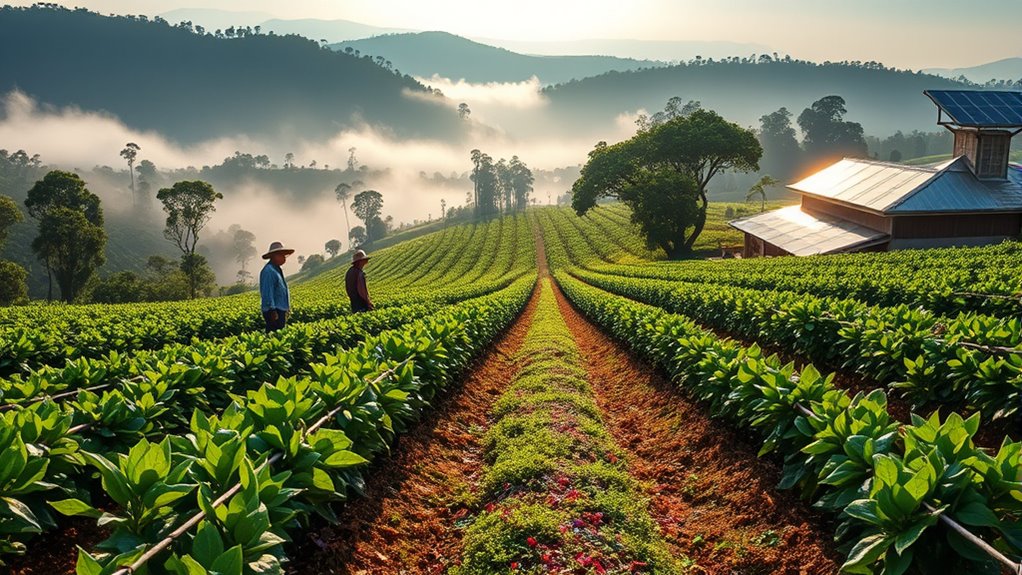
As climate change continues to threaten coffee production, smallholder farmers are finding innovative ways to adapt and thrive.
They’re increasingly using resilient coffee varieties, like Castillo 2.0, to combat pests and diseases exacerbated by rising temperatures. In Uganda, farmers adjust planting dates and boost pesticide use to align with shifting weather patterns.
Meanwhile, Ethiopian farmers implement mixed farming practices and enhance shade cover, creating microclimates that protect their coffee plants. Many are returning to traditional shade-grown coffee methods, which promote biodiversity and mitigate temperature extremes.
Collaboration with research institutions, such as Cenicafé, is essential for developing these strategies and equipping farmers with the knowledge and resources necessary for effective climate change adaptation and sustainable practices.
The Role of Sustainable Farming Practices
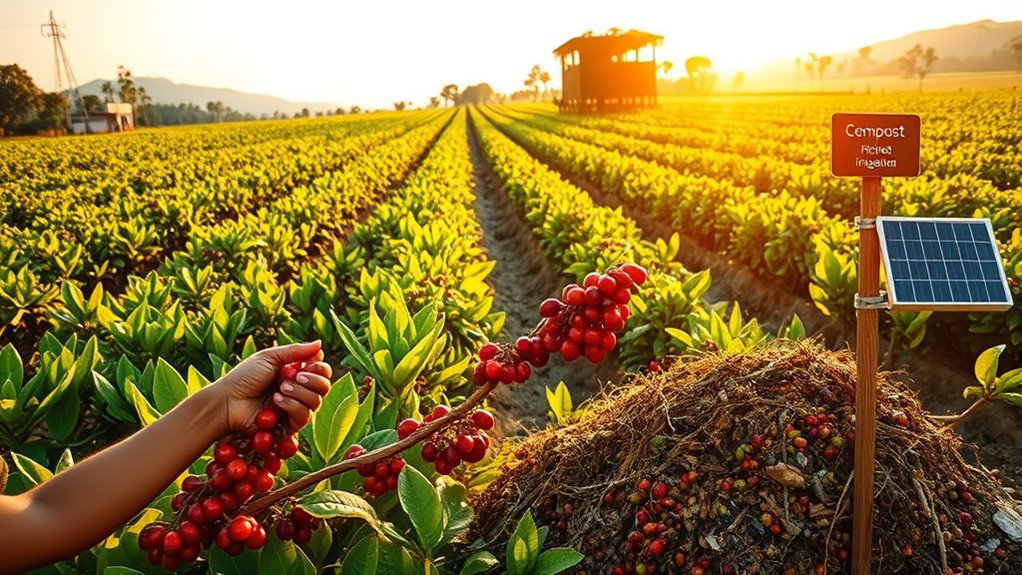
Coffee farmers are increasingly recognizing the importance of sustainable farming practices in their efforts to adapt to climate challenges.
By adopting shade-grown coffee methods, you can cool your plants and conserve moisture, helping to mitigate heat stress. Utilizing organic fertilizers allows you to support sustainable growth while reducing harmful chemical inputs.
Adopting shade-grown methods and organic fertilizers enhances moisture conservation and promotes sustainable growth in coffee farming.
Implementing water-saving irrigation systems enables you to optimize water usage, especially in response to changing rainfall patterns.
These sustainable practices not only enhance the climate resilience of your coffee crops but also promote biodiversity, creating healthier ecosystems.
As you face pests and diseases, these adaptation strategies become essential for maintaining productivity under varying environmental conditions, ensuring a more sustainable future for coffee farming.
Collaboration With Research Institutions for Resilience
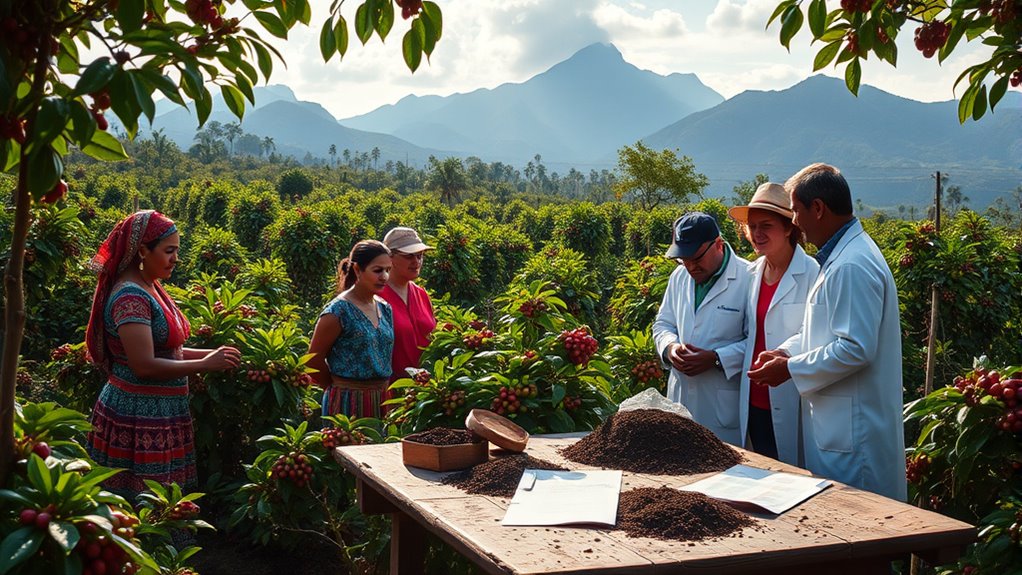
While many farmers face increasing climate-related challenges, collaboration with research institutions is proving crucial for resilience in coffee production.
By partnering with organizations like World Coffee Research and Cenicafé, you can access essential research on coffee varieties that resist climate impacts. These collaborations focus on advanced plant breeding techniques to develop hybrids that withstand diseases and pests worsened by climate change.
For instance, the Castillo 2.0 variety enhances resilience for 87.5% of Colombia’s coffee production. Additionally, ongoing research into genetic diversity strengthens your plants against evolving threats.
With knowledge and climate-smart agricultural techniques from these partnerships, you can improve sustainability and support smallholder farmers in adapting to an uncertain future.
Balancing Tradition and Modern Techniques
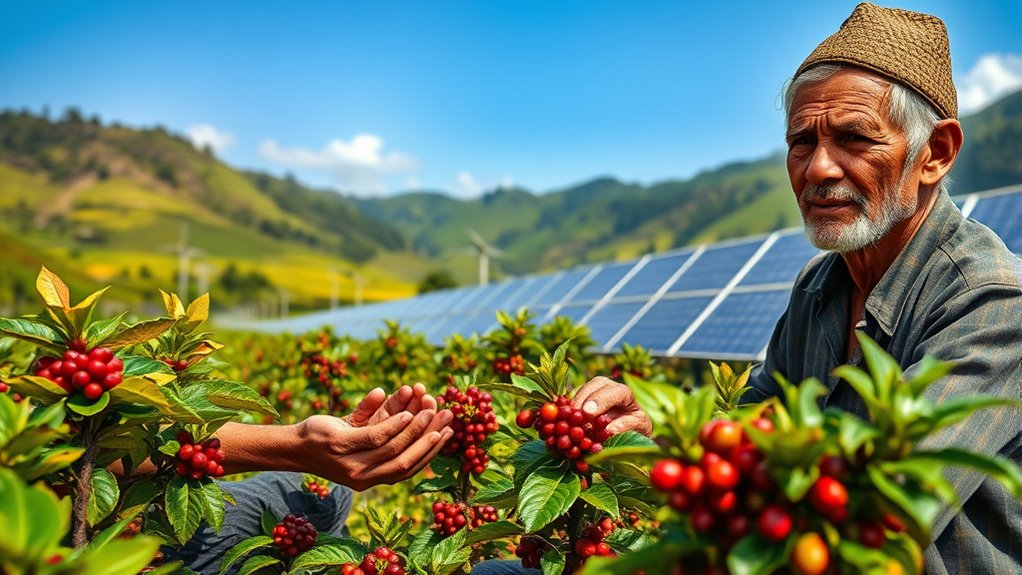
Maneuvering the complexities of modern coffee farming requires a delicate balance between tradition and innovation. Coffee farmers are increasingly turning to traditional practices, like shade-grown methods, which promote biodiversity and create microclimates that buffer against climate change.
While these techniques can lead to lower yields, they enhance resilience against pests and diseases, proving their worth in sustainable farming. Some producers prioritize non-hybrid varieties, like Geisha, to access high-quality markets, while others, like Gerardo Carvajal, successfully combine modern rust-resistant hybrids with organic methods.
Economic Impacts and Social Dynamics in Coffee Farming
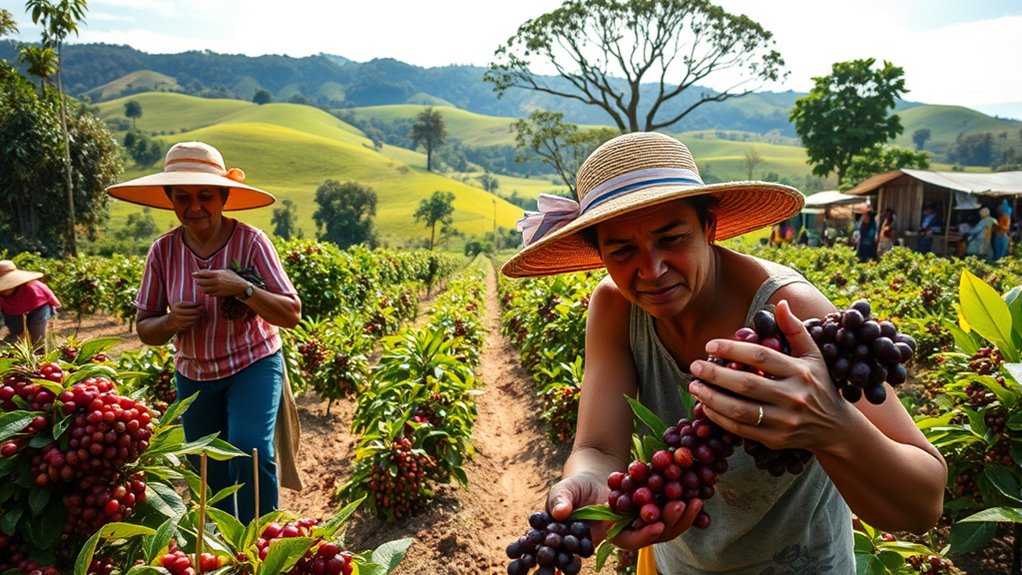
As the coffee industry grapples with economic volatility and social challenges, smallholder farmers often find themselves in precarious situations. Producing about 60% of the world’s coffee, these farmers face financial instability due to volatile prices that frequently fall below production costs.
Climate change exacerbates their struggles, while social inequalities, particularly affecting women, limit access to land and leadership roles. Cooperative structures can empower farmers to negotiate better market terms and access training, enhancing both economic resilience and social equity through Fairtrade initiatives.
However, limited resources hinder their ability to invest in sustainable practices, perpetuating cycles of poverty. Education on sustainable farming is essential to improve their conditions and adapt to market demands effectively.
Frequently Asked Questions
What Are the Challenges Facing Coffee Farmers?
Coffee farmers face numerous challenges that threaten their livelihoods.
You’re dealing with the impacts of climate change, which can lead to a drastic decline in coffee production. Unpredictable weather disrupts flowering and ripening cycles, while pests and diseases become more prevalent.
Economic pressures from volatile prices often leave you struggling to cover production costs. Limited access to resources and education further complicates your ability to implement sustainable practices, perpetuating cycles of poverty.
How Does a Coffee Plant Adapt to Its Environment?
You might think coffee plants can’t handle environmental changes, but they actually adapt quite well.
They develop resistance to diseases and pests through selective breeding. You’ll also find that shade-grown practices help regulate temperature and conserve moisture, creating microclimates.
By relocating to higher elevations, coffee plants can thrive in cooler temperatures.
Plus, implementing sustainable farming methods promotes healthier growth, allowing your coffee plants to withstand stress from changing conditions.
How Do Farmers Adapt?
You adapt by embracing new techniques and practices tailored to your local environment.
You might start using improved seeds or changing crop varieties to boost resilience against unpredictable weather.
By adjusting planting dates and increasing pesticide use, you tackle immediate challenges.
Implementing shade and mixed farming can create a healthier ecosystem, while adopting sustainable methods like organic fertilizers helps guarantee long-term productivity.
Your proactive approach directly impacts your coffee yields and environmental health.
What Are the Current Challenges Faced by the Coffee Bean Industry?
Picture a once-vibrant coffee plantation, now struggling under the weight of climate change. You’re witnessing erratic weather patterns that disrupt the delicate balance of flowering and ripening cycles.
Farmers like you face severe yield declines and rising pest pressures, while volatile green coffee prices threaten your financial stability.
With limited access to resources and education, adapting to these challenges feels like steering through a stormy sea without a compass.
The future’s uncertain, and it’s overwhelming.
Conclusion
You might think that coffee farming is stuck in its ways, but that’s far from the truth. Farmers are actively embracing innovative strategies and sustainable practices to tackle climate change and market demands. By collaborating with research institutions and blending tradition with modern techniques, they’re not just surviving—they’re thriving. This adaptability guarantees a vibrant future for coffee farming, benefiting communities and consumers alike. So, next time you sip your coffee, remember the resilience behind every cup!









